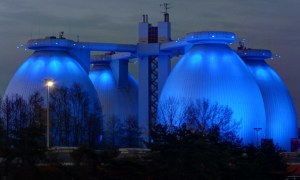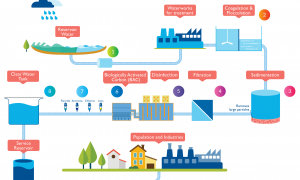🕑 Reading time: 1 minute
A pumping station is used in a water distribution system for efficient and reliable transportation and dissemination of water from one site to another. At the station, the water is pumped into the system and the pressure is modulated based on the slope. This arrangement is made to compensate for the differences in water levels under the influence of gravity.
The devices in the pumping station are capable of supplying water to canals, circulating water in treatment systems, and draining water from low-lying lands. The capital costs for running a pumping station are high, and the pumps require a huge amount of electricity to operate. It thus becomes very important to ensure that the most feasible design is finalized in the planning stage, giving due consideration to the efficiency of pumps and maintenance.
Contents:
1. Site of the Pumping Station
The site of the pumping station primarily depends on the location of the water source and the place it has to be supplied. In addition to this, the following factors should be considered:
- The site of the pumping station must be far away from any sources of pollution and contamination.
- The elevation of the site should be higher than the highest flood level of the river or the water source.
- If the source is a river, the site of the pumping station should be such that the machinery setup is capable of drawing adequate water to meet the peak demand at the busiest time of the day. This requires an exhaustive study on parameters such as a change in river course, dry weather flow, etc.
- The site should permit future expansion and growth.
- Possibilities and risks of a fire hazard for the site should be as minimal as possible.
- The proximity of the location with the nearest power station, railway station, etc. should be considered.
The premises of the pumping station should be clean and well-maintained. The setup must be designed to ensure proper ventilation and illumination. The engine and the pumping units must be spread out to provide ample space for operation, maintenance, repairs, and cleaning.

2. Setting up the Pumps
The level of the pumps in the pumping station can be either above the sump well or below it. In the latter case, no difficulties would be faced during priming, but the pumps should be placed in an adjacent dry pit. It can then be connected to a common suction pipe using sluice valves.
This type of setup easily provides a positive suction head and serves as an additional benefit for centrifugal pumps (if used). The electric motors and machines should be placed in a dry area having higher elevation.
In case the pumps are to be placed above the sump well, the elevation depends on the suction lift of the pump and on factors such as atmospheric pressure, the velocity of water in suction pipes, losses, etc. The elevation is generally limited to 5 meters.
The suction pipe should be kept as short as possible to avoid losses, and the portion from the foot valve to the pump should have an upward slope to avoid air pockets. The electric motors (driving machines) can be placed at the same elevation as the pumps.
3. Piping and Valves
A layout of a conventional pumping station can be seen in Figure-1. Generally, cast iron pipes with flanged joints are provided. The velocity of water in the pipe varies from 0.6 to 1.2 m/s approximately.
Multiple valves are used in the system and are as follows:
3.1 Gate or Sluice Valves
Sluice valves are provided on the suction side and the delivery side.
3.2 Check Valve
The check valve is placed between the pump and gate valve on the delivery side.
3.3 Air Valve and Pressure Relief Valve
The air valve and a pressure relief valve should be positioned on the delivery side.
4. Sizing of Units and Standby Capacity
Practically, a pumping station is not always operated at its maximum capacity. The efficiency varies as per the load on the pumping unit, and thus, it is a usual practice to design the station such that some units of the pump can be harnessed on full capacity all the time. This is the reason two or more pumps are installed as standby. Attributes such as available storage, demand, etc. contribute to finalizing the size of the pump.
Some pumps may comply with the maximum demand, while others may cater to the minimum requirement. A standby capacity will always be provided to handle breakdowns, repairs, etc. Usually, 33% to 50% standby capacity is provided against the peak demand, and 100% standby capacity is provided against the average demand at any water pumping station.
FAQs
A pumping station is used for efficient and reliable transportation and distribution of water from one site to another.
Sluice valves, check valves, air valves, and pressure valves are the types of valves used in a pumping station.
The site of the pumping station primarily depends on the location of the water source and the place it has to be supplied.
Read More
COMPARISON BETWEEN CENTRIFUGAL & RECIPROCATING PUMPS



